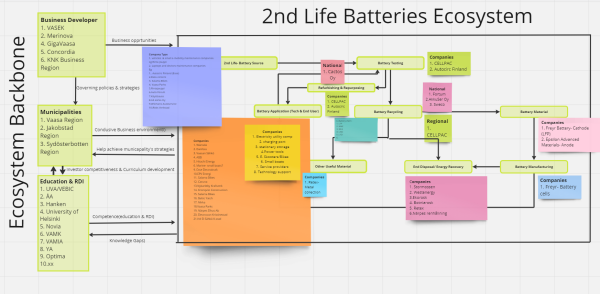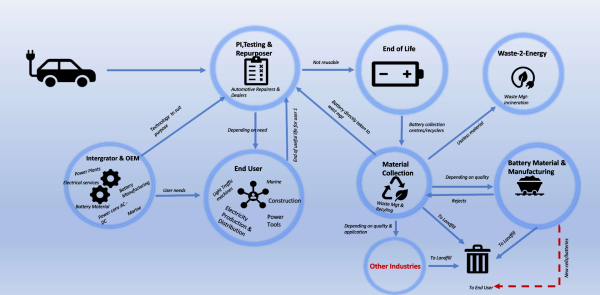Towards the green transition with used electric vehicle batteries – Ostrobothnia perspective

The article was published in Vaasa Insider 19.9.2023.
Cynthia Söderbacka is a Project Leader at Novia UAS writing about findings from the project ”Developing Battery 2nd-life Business in Ostrobothnia”, funded by the Regional Council of Ostrobotnia with VAMK, Novia UAS, VEBIC and Åbo Akademi (ÅA) as project partners.
The transport sector is the biggest consumer of lithium-ion batteries (LiBs) and the demand for LiBs is expected to continue to grow, with an estimated capacity of 4,700 GWh by 2030. The challenge with this is that minerals and metals must be mined and are limited to certain geographical locations.
Moreover, the extraction of these naturally occurring minerals and metals are energy intense, contributes to air and water pollution, and in some cases have ethical conflicts such depletion of fresh water for human use, lack of safe working environment, as well as land use conflicts (Campbell, 2022) (Li & Lu, 2020).
With this view, the retired electric vehicle (EV) LiBs have a role to play in the green transition and strengthening circular economies in the battery value chains. The LiBs application in EVs are said to reach end-of-life when they reach 70-80 percent of their original capacity due to the high energy and power density requirements in that application (Börner et al., 2022).
Depending on State of Health (SoH), the batteries can be moved to less demanding applications as a second-life battery (SLB) or recovering of resources.
Getting ready for second-life batteries in Ostobothnia
The project ”Developing Battery 2nd-life Business in Ostrobothnia” has given out a report on the possibilities for second-life batteries in the region. The mapping exercise aimed at giving an outlook for the Ostrobothnia region on how the high influx of batteries can be used to grow businesses organically in the region by looking at various actors in the ecosystem with their value chains by assessing the interest and needs.
The data collected was used as input data by ÅA and VAMK to create business models from pack to cell level, incorporating time recorded from the dismantling process and legislation regarding SLBs. VAMK also worked on Tesla Model S battery module (Figure 1) to document the dismantling process.
VEBIC tested the state of health of some of the cells with the battery test equipment available in VEBIC and looked into the safety aspect of second-life batteries. Novia UAS weighed all material streams from the dismantling process to give an understanding of other materials and waste management from battery dismantling.
The mapping exercise was carried out after a study of activities that are required to build an ecosystem and different actors from within the region identified, as shown in Figure 2. The actors were identified or found through involvement in past and ongoing projects, recommendations, press releases, company websites and regional business developers (published material and contacts) and other public platforms.
Data was collected using a questionnaire comprising of nine questions and reached out to more than 30 companies, response rate was 33 percent targeting organisations in Figure 2.

The findings from the survey are that there is interest from different types of companies in the region depending on role, but concerns on safety, legislation, guarantee of performance and profitability currently hinder their acceptance.
Looking at different factors for Ostrobothnia, such as population and the battery ecosystems with their value chains (shown in Figure 3), realizing the entire ecosystem as a region will call for strong collaborations amongst the players to create symbiosis for easy and profitable flows.

The region has been preparing for the battery manufacturing or material factory, like other regions in the battery belt such as Skellefteå and Mo i Rana in Sweden and Norway respectively. That particular industry requires a large work force with various skill sets, as confirmed in reports on ALBATTS project (2023) and BATTKOMP Norsk Industri (2023).
The SLB ecosystem in Finland will probably be on a national level with regions focusing on one or more roles depending on availability of resources.
In conclusion, it is not clear cut on what the major path will be for retired EV batteries, to recycle or reuse. The key driver for what will happen to the retired EV batteries will depend on the demands from legislation both on global and regional targets and clear rules for various applications that protect the environment and end user.
For the Ostrobothnia region, the current population (volume of EVs) gives it time to learn from other regions and develop business models that will suit its needs and expertise. As Börner et al. (2022) points out, ”Saxena et al. have suggested alternative end-of-life criteria that are determined by user needs rather than fixed theoretical values.”
